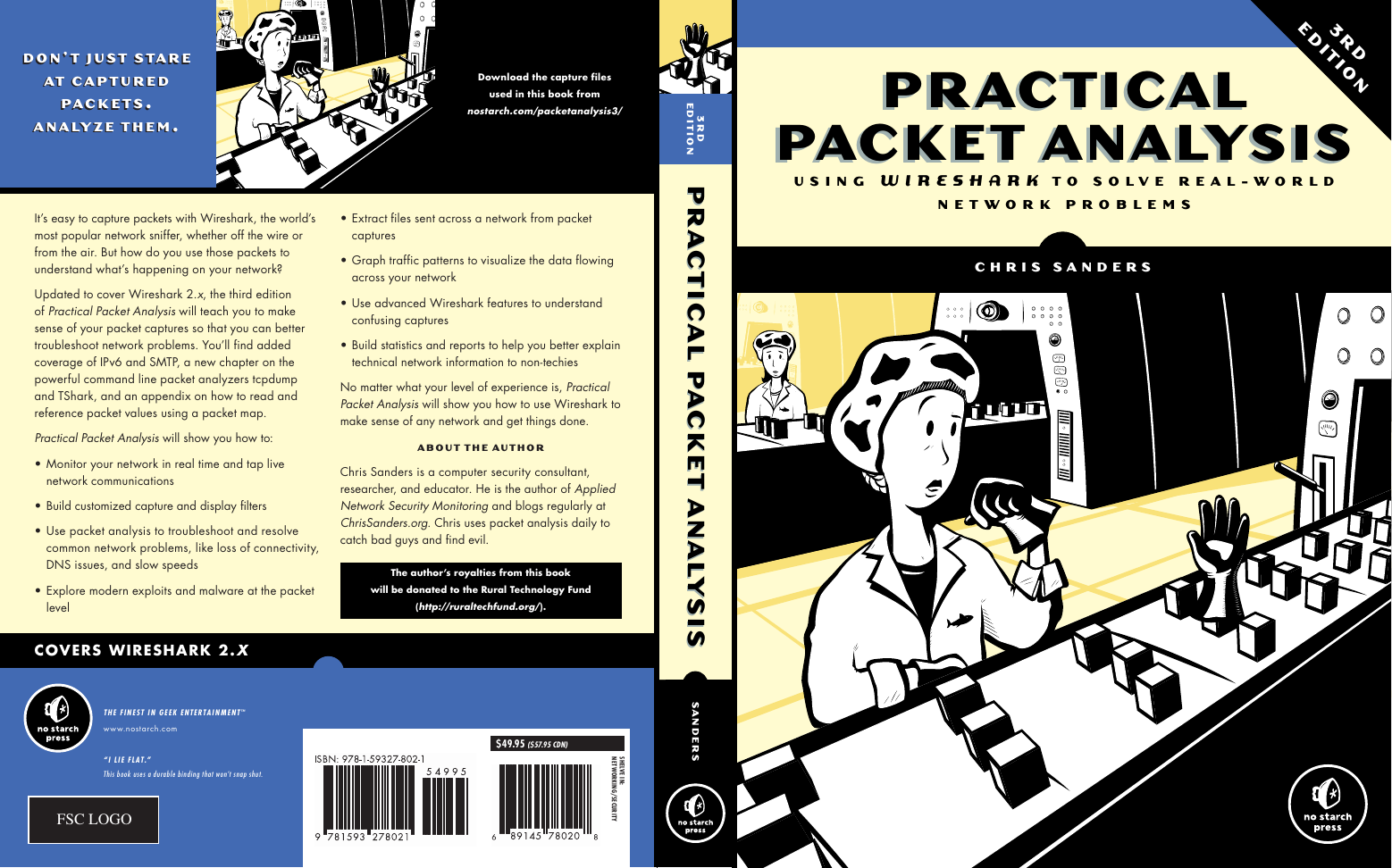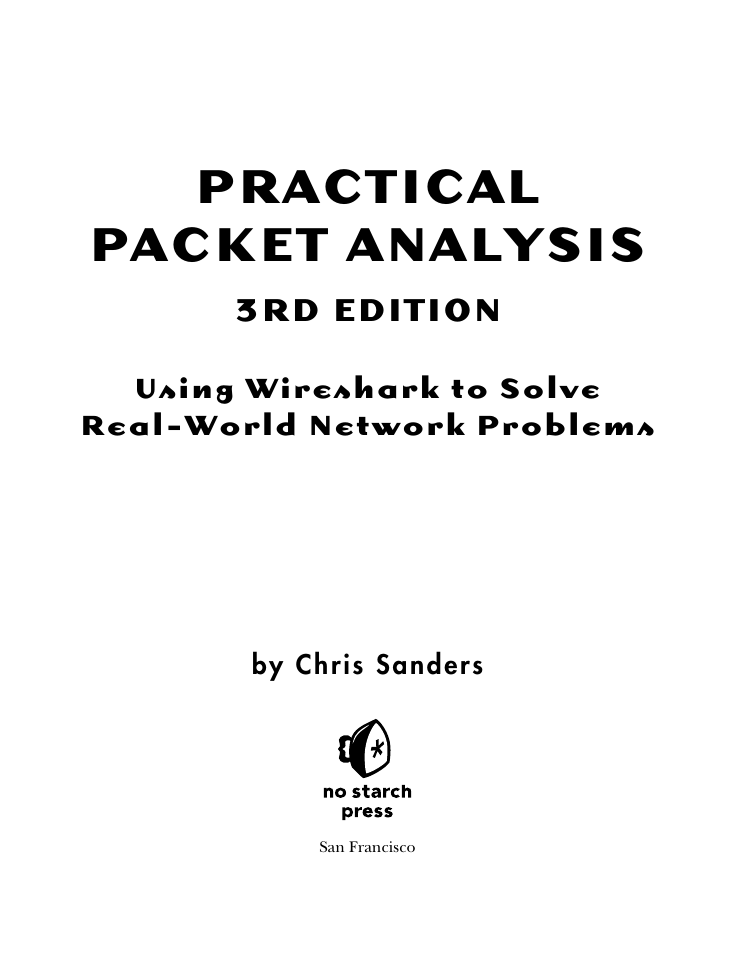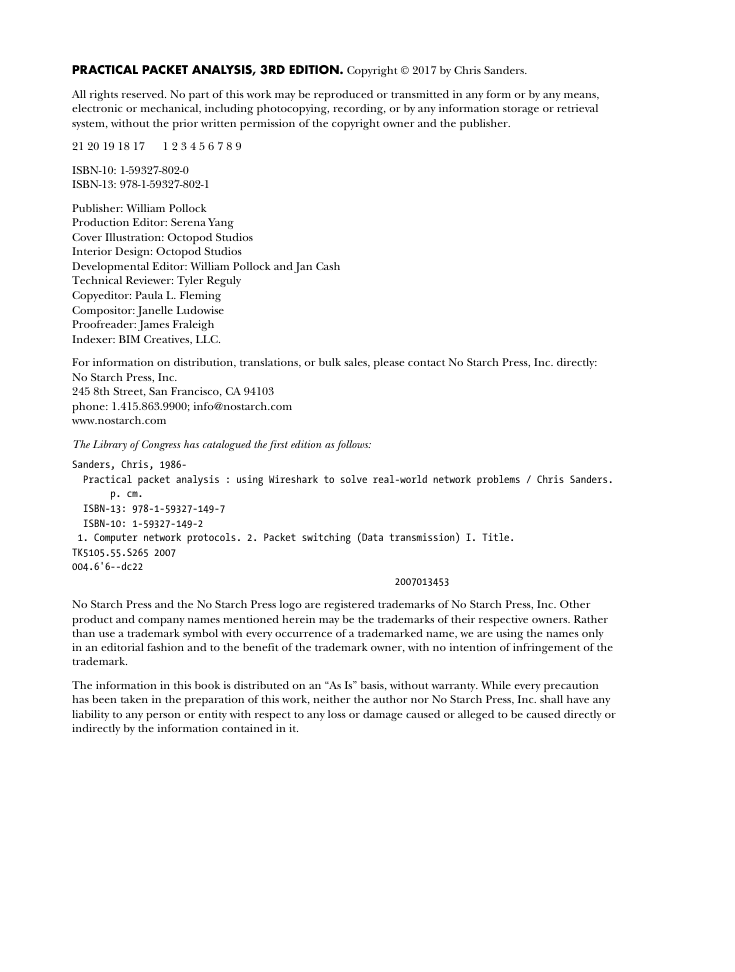Brief Contents
Contents in Detail
Acknowledgments
Introduction
Why This Book?
Concepts and Approach
How to Use This Book
About the Sample Capture Files
The Rural Technology Fund
Contacting Me
Chapter 1: Packet Analysis and
Network Basics
Packet Analysis and Packet Sniffers
Evaluating a Packet Sniffer
How Packet Sniffers Work
How Computers Communicate
Protocols
The Seven-Layer OSI Model
Network Hardware
Traffic Classifications
Broadcast Traffic
Multicast Traffic
Unicast Traffic
Final Thoughts
Chapter 2: Tapping into the Wire
Living Promiscuously
Sniffing Around Hubs
Sniffing in a Switched Environment
Port Mirroring
Hubbing Out
Using a Tap
ARP Cache Poisoning
Sniffing in a Routed Environment
Sniffer Placement in Practice
Chapter 3: Introduction to Wireshark
A Brief History of Wireshark
The Benefits of Wireshark
Installing Wireshark
Installing on Windows Systems
Installing on Linux Systems
Installing on OS X Systems
Wireshark Fundamentals
Your First Packet Capture
Wireshark’s Main Window
Wireshark Preferences
Packet Color Coding
Configuration Files
Configuration Profiles
Chapter 4: Working with Captured Packets
Working with Capture Files
Saving and Exporting Capture Files
Merging Capture Files
Working with Packets
Finding Packets
Marking Packets
Printing Packets
Setting Time Display Formats and References
Time Display Formats
Packet Time Referencing
Time Shifting
Setting Capture Options
Input Tab
Output Tab
Options Tab
Using Filters
Capture Filters
Display Filters
Saving Filters
Adding Display Filters to a Toolbar
Chapter 5: Advanced Wireshark Features
Endpoints and Network Conversations
Viewing Endpoint Statistics
Viewing Network Conversations
Identifying Top Talkers with Endpoints and Conversations
Protocol Hierarchy Statistics
Name Resolution
Enabling Name Resolution
Potential Drawbacks to Name Resolution
Using a Custom hosts File
Manually Initiated Name Resolution
Protocol Dissection
Changing the Dissector
Viewing Dissector Source Code
Following Streams
Following SSL Streams
Packet Lengths
Graphing
Viewing IO Graphs
Round-Trip Time Graphing
Flow Graphing
Expert Information
Chapter 6: Packet Analysis on the Command Line
Installing TShark
Installing tcpdump
Capturing and Saving Packets
Manipulating Output
Name Resolution
Applying Filters
Time Display Formats in TShark
Summary Statistics in TShark
Comparing TShark and tcpdump
Chapter 7: Network Layer Protocols
Address Resolution Protocol (ARP)
ARP Packet Structure
Packet 1: ARP Request
Packet 2: ARP Response
Gratuitous ARP
Internet Protocol
Internet Protocol Version 4 (IPv4)
Internet Protocol version 6 (IPv6)
Internet Control Message Protocol
ICMP Packet Structure
ICMP Types and Messages
Echo Requests and Responses
traceroute
ICMP version 6 (ICMPv6)
Chapter 8: Transport Layer Protocols
Transmission Control Protocol (TCP)
TCP Packet Structure
TCP Ports
The TCP Three-Way Handshake
TCP Teardown
TCP Resets
User Datagram Protocol (UDP)
UDP Packet Structure
Chapter 9: Common Upper-Layer Protocols
Dynamic Host Configuration Protocol (DHCP)
The DHCP Packet Structure
The DHCP Initialization Process
DHCP In-Lease Renewal
DHCP Options and Message Types
DHCPv6
Domain Name System (DNS)
The DNS Packet Structure
A Simple DNS Query
DNS Question Types
DNS Recursion
DNS Zone Transfers
Hypertext Transfer Protocol (HTTP)
Browsing with HTTP
Posting Data with HTTP
Simple Mail Transfer Protocol (SMTP)
Sending and Receiving Email
Tracking an Email Message
Sending Attachments via SMTP
Final Thoughts
Chapter 10: Basic Real-World Scenarios
Missing Web Content
Tapping into the Wire
Analysis
Lessons Learned
Unresponsive Weather Service
Tapping into the Wire
Analysis
Lessons Learned
No Internet Access
Gateway Configuration Problems
Unwanted Redirection
Upstream Problems
Inconsistent Printer
Tapping into the Wire
Analysis
Lessons Learned
No Branch Office Connectivity
Tapping into the Wire
Analysis
Lessons Learned
Software Data Corruption
Tapping into the Wire
Analysis
Lessons Learned
Final Thoughts
Chapter 11: Fighting a Slow Network
TCP Error-Recovery Features
TCP Retransmissions
TCP Duplicate Acknowledgments and Fast Retransmissions
TCP Flow Control
Adjusting the Window Size
Halting Data Flow with a Zero Window Notification
The TCP Sliding Window in Practice
Learning from TCP Error-Control and Flow-Control Packets
Locating the Source of High Latency
Normal Communications
Slow Communications: Wire Latency
Slow Communications: Client Latency
Slow Communications: Server Latency
Latency Locating Framework
Network Baselining
Site Baseline
Host Baseline
Application Baseline
Additional Notes on Baselines
Final Thoughts
Chapter 12: Packet Analysis for Security
Reconnaissance
SYN Scan
Operating System Fingerprinting
Traffic Manipulation
ARP Cache Poisoning
Session Hijacking
Malware
Operation Aurora
Remote-Access Trojan
Exploit Kit and Ransomware
Final Thoughts
Chapter 13: Wireless Packet Analysis
Physical Considerations
Sniffing One Channel at a Time
Wireless Signal Interference
Detecting and Analyzing Signal Interference
Wireless Card Modes
Sniffing Wirelessly in Windows
Configuring AirPcap
Capturing Traffic with AirPcap
Sniffing Wirelessly in Linux
802.11 Packet Structure
Adding Wireless-Specific Columns to the Packet List Pane
Wireless-Specific Filters
Filtering Traffic for a Specific BSS ID
Filtering Specific Wireless Packet Types
Filtering a Specific Frequency
Saving a Wireless Profile
Wireless Security
Successful WEP Authentication
Failed WEP Authentication
Successful WPA Authentication
Failed WPA Authentication
Final Thoughts
Appendix A: Further Reading
Packet Analysis Tools
CloudShark
WireEdit
Cain & Abel
Scapy
TraceWrangler
Tcpreplay
NetworkMiner
CapTipper
ngrep
libpcap
Npcap
hping
Python
Packet Analysis Resources
Wireshark’s Home Page
Practical Packet Analysis Online Course
SANS’s Security Intrusion Detection In-Depth Course
Chris Sanders’s Blog
Brad Duncan’s Malware Traffic Analysis
IANA’s Website
W. Richard Stevens’s TCP/IP Illustrated Series
The TCP/IP Guide
Appendix B: Navigating Packets
Packet Representation
Using Packet Diagrams
Navigating a Mystery Packet
Final Thoughts
Index
Blank Page
Blank Page
















 2023年江西萍乡中考道德与法治真题及答案.doc
2023年江西萍乡中考道德与法治真题及答案.doc 2012年重庆南川中考生物真题及答案.doc
2012年重庆南川中考生物真题及答案.doc 2013年江西师范大学地理学综合及文艺理论基础考研真题.doc
2013年江西师范大学地理学综合及文艺理论基础考研真题.doc 2020年四川甘孜小升初语文真题及答案I卷.doc
2020年四川甘孜小升初语文真题及答案I卷.doc 2020年注册岩土工程师专业基础考试真题及答案.doc
2020年注册岩土工程师专业基础考试真题及答案.doc 2023-2024学年福建省厦门市九年级上学期数学月考试题及答案.doc
2023-2024学年福建省厦门市九年级上学期数学月考试题及答案.doc 2021-2022学年辽宁省沈阳市大东区九年级上学期语文期末试题及答案.doc
2021-2022学年辽宁省沈阳市大东区九年级上学期语文期末试题及答案.doc 2022-2023学年北京东城区初三第一学期物理期末试卷及答案.doc
2022-2023学年北京东城区初三第一学期物理期末试卷及答案.doc 2018上半年江西教师资格初中地理学科知识与教学能力真题及答案.doc
2018上半年江西教师资格初中地理学科知识与教学能力真题及答案.doc 2012年河北国家公务员申论考试真题及答案-省级.doc
2012年河北国家公务员申论考试真题及答案-省级.doc 2020-2021学年江苏省扬州市江都区邵樊片九年级上学期数学第一次质量检测试题及答案.doc
2020-2021学年江苏省扬州市江都区邵樊片九年级上学期数学第一次质量检测试题及答案.doc 2022下半年黑龙江教师资格证中学综合素质真题及答案.doc
2022下半年黑龙江教师资格证中学综合素质真题及答案.doc